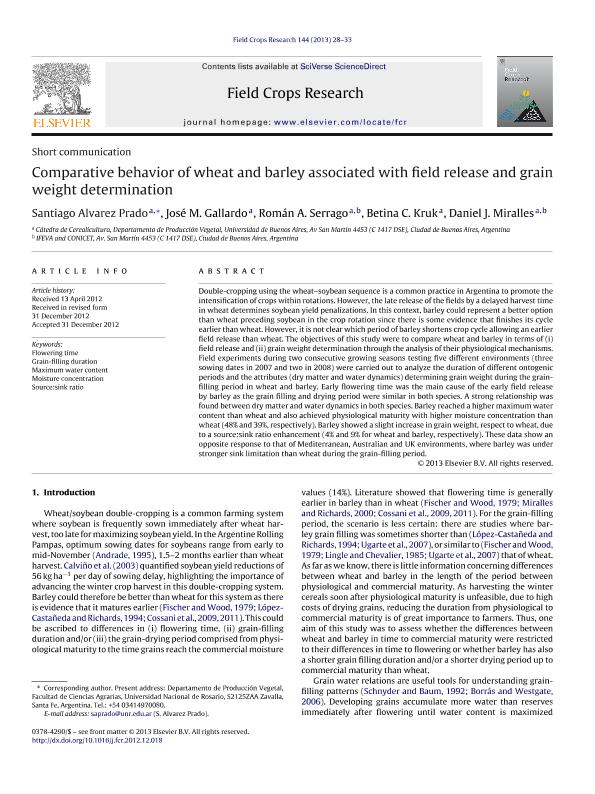Mostrar el registro sencillo del ítem
dc.contributor.author
Alvarez Prado, Santiago

dc.contributor.author
Gallardo, Jose Manuel
dc.contributor.author
Serrago, Roman Augusto

dc.contributor.author
Kruk, Betina Claudia
dc.contributor.author
Miralles, Daniel Julio

dc.date.available
2016-01-13T13:36:46Z
dc.date.issued
2013-03-20
dc.identifier.citation
Alvarez Prado, Santiago; Gallardo, Jose Manuel; Serrago, Roman Augusto; Kruk, Betina Claudia; Miralles, Daniel Julio; Comparative behavior of wheat and barley associated with field release and grain weight determination; Elsevier; Field Crops Research; 144; 20-3-2013; 28-33
dc.identifier.issn
0378-4290
dc.identifier.uri
http://hdl.handle.net/11336/3572
dc.description.abstract
Double-cropping using the wheat?soybean sequence is a common practice in Argentina to promote the intensification of crops within rotations. However, the late release of the fields by a delayed harvest time in wheat determines soybean yield penalizations. In this context, barley could represent a better option than wheat preceding soybean in the crop rotation since there is some evidence that finishes its cycle earlier than wheat. However, it is not clear which period of barley shortens crop cycle allowing an earlier field release than wheat. The objectives of this study were to compare wheat and barley in terms of (i) field release and (ii) grain weight determination through the analysis of their physiological mechanisms. Field experiments during two consecutive growing seasons testing five different environments (three sowing dates in 2007 and two in 2008) were carried out to analyze the duration of different ontogenic periods and the attributes (dry matter and water dynamics) determining grain weight during the grainfilling period in wheat and barley. Early flowering time was the main cause of the early field release by barley as the grain filling and drying period were similar in both species. A strong relationship was found between dry matter and water dynamics in both species. Barley reached a higher maximum water content than wheat and also achieved physiological maturity with higher moisture concentration than wheat (48% and 39%, respectively). Barley showed a slight increase in grain weight, respect to wheat, due to a source:sink ratio enhancement (4% and 9% for wheat and barley, respectively). These data show an opposite response to that of Mediterranean, Australian and UK environments, where barley was under stronger sink limitation than wheat during the grain-filling period.
dc.format
application/pdf
dc.language.iso
eng
dc.publisher
Elsevier

dc.rights
info:eu-repo/semantics/openAccess
dc.rights.uri
https://creativecommons.org/licenses/by-nc-nd/2.5/ar/
dc.subject
Flowering Time
dc.subject
Grain-Filling Duration
dc.subject
Maximum Water Content
dc.subject
Moisture Concentration
dc.subject
Source:Sink Ratio
dc.subject.classification
Agricultura

dc.subject.classification
Agricultura, Silvicultura y Pesca

dc.subject.classification
CIENCIAS AGRÍCOLAS

dc.title
Comparative behavior of wheat and barley associated with field release and grain weight determination
dc.type
info:eu-repo/semantics/article
dc.type
info:ar-repo/semantics/artículo
dc.type
info:eu-repo/semantics/publishedVersion
dc.date.updated
2016-03-30 10:35:44.97925-03
dc.journal.volume
144
dc.journal.pagination
28-33
dc.journal.pais
Países Bajos

dc.journal.ciudad
Amsterdam
dc.description.fil
Fil: Alvarez Prado, Santiago. Universidad de Buenos Aires. Facultad de Agronomía. Departamento de Producción Vegetal. Cátedra de Cerealicultura; Argentina
dc.description.fil
Fil: Gallardo, Jose Manuel. Universidad de Buenos Aires. Facultad de Agronomía. Departamento de Producción Vegetal. Cátedra de Cerealicultura; Argentina
dc.description.fil
Fil: Serrago, Roman Augusto. Universidad de Buenos Aires. Facultad de Agronomía. Departamento de Producción Vegetal. Cátedra de Cerealicultura; Argentina. Consejo Nacional de Investigaciones Científicas y Técnicas. Oficina de Coordinación Administrativa Parque Centenario. Instituto de Investigaciones Fisiológicas y Ecológicas Vinculadas a la Agricultura; Argentina
dc.description.fil
Fil: Kruk, Betina Claudia. Universidad de Buenos Aires. Facultad de Agronomía. Departamento de Producción Vegetal. Cátedra de Cerealicultura; Argentina
dc.description.fil
Fil: Miralles, Daniel Julio. Universidad de Buenos Aires. Facultad de Agronomía. Departamento de Producción Vegetal. Cátedra de Cerealicultura; Argentina. Consejo Nacional de Investigaciones Científicas y Técnicas. Oficina de Coordinación Administrativa Parque Centenario. Instituto de Investigaciones Fisiológicas y Ecológicas Vinculadas a la Agricultura; Argentina
dc.journal.title
Field Crops Research

dc.relation.alternativeid
info:eu-repo/semantics/altIdentifier/url/http://www.sciencedirect.com/science/article/pii/S0378429013000063
dc.relation.alternativeid
info:eu-repo/semantics/altIdentifier/doi/http://dx.doi.org/10.1016/j.fcr.2012.12.018
dc.relation.alternativeid
info:eu-repo/semantics/altIdentifier/issn/0378-4290
Archivos asociados
